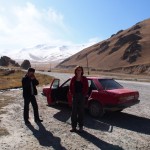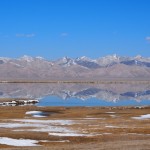Those of you who know me personally and professionally may be surprised to learn that insurance was not my first intellectual interest. That dubious honour goes to engineering – four happy years at Cambridge studying everything from the performance of jet engines to the design of transistors and all that falls in between. And a topic that has sprung to mind recently has been metal fatigue: the process by which a metal body is stressed repeatedly (although not quite to breaking point) until it suddenly gives way without warning well below its design limits. This process leaves a distinctive fracture: bright, shiny and beautiful where the repeated stress has worn away at the edges of the body, then matt, dark and ugly where the final catastrophic failure occurred.
We have just crossed the Torugart Pass. Wildly scenic, this pass winds its way from the rugged south of Kyrgyzstan through the snow-capped Tian Shan mountains to the far western reaches of China. It is remote and deserted, and sees relatively few foreigners due to the extraordinary bureaucratic procedures required to get across it. No fewer than five separate checkpoints, with gun-toting soldiers at each checking your documents, luggage checks, x-rays, form filling and long waits (including one spent standing alone outside the closed gates of China – in case you are wondering, they are high and desolate with five-pointed communist stars and lions on them). You need two drivers, two cars (one Kyrgyz, one Chinese) and all the right documents, and it is an expensive pain in the arse. And you can guess where this post is going, yes? The metal fatigue analogy is all a build up to some spectacular bureaucracy-induced sense of humour failure, right?
Wrong. Lucy and I were actually pretty chilled about all the bureaucracy, as we had employed a specialist travel agent and had managed our expectations extremely hard before we set off. We literally (and by “literally”, I once again mean “literally”) sat back and enjoyed the view. The Big Issue was that once we had got over the pass and were speeding down the road to Kashgar … the back wheel of our car fell off.
Nobody was hurt; nobody was killed. The wheel was – very, very, very fortunately – trapped by the brake disk and the brake pad and merely got stuck at an angle to the car, thereby bringing us to a screeching halt. Indeed, it wasn’t immediately apparent that the back axle had sheared completely off until the driver and I removed the wheel and stuck our heads under the car. There I saw the distinctive (textbook even) pattern of shiny and matt fractures across the inch-thick metal shaft and had a cold sweat moment when I realized what had happened. The driver was still making reassuring noises about “problem with the brakes” when we left him, picked up by the only other tourists who were crossing the pass that day. How the driver got his car picked up we don’t know, and we will never know – you see, we agreed to pay him the $170 for the Chinese side of our trip once we reached Kashgar and, while we made it in one piece in our third car of the day, we have never seen him since.
- Lucy and the first of our cars – the one that retained all four wheels
- That’s the horrible thing about the Kyrgyz silk road – all the other tourists
- This is the kind of view that simply does not come out on photographs. It went on for hours…




I had to look online to see some of the metal fatigue pictures. Lots of crank shafts and bicycle parts. They seem to say the opposite though, James, that the dark, matte sections are the chronic build up and the shiny section is the sudden shearing of the metal. I am glad you two are doing well and weren’t injured by the “brake problems”.
Hmmm. Well, technically shininess and darkness depend on the ductility of the metal (allowing the gradual striated bit to become shiny) and the crystal grain size (the smaller, the darker a brittle fracture). A rapidly quenched medium to high carbon steel axle shaft should be shiny where fatigued, and dark where broken. But let’s not let the technicalities get in the way, eh?